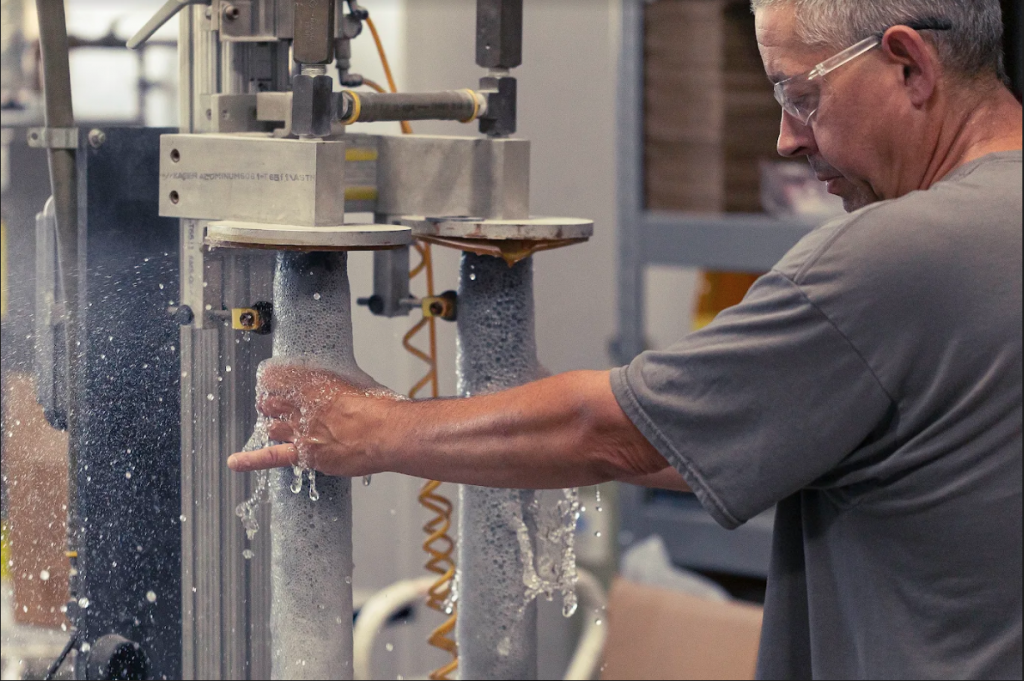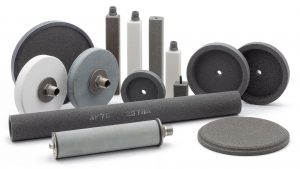Porous ceramics are used for a variety of applications, often as filters, wicks and diffusers or spargers. They may become clogged over time but thankfully porous ceramics can often be cleaned and returned to a like new condition.
This article highlights several methods that can be evaluated for cleaning glass bonded porous alumina and silicon carbide ceramics.
What’s The Contaminent?
There are three main types of contaminants that affect porous ceramic product performance. They are:
- Inorganic contaminants: typically consists of solids of metals, salts, oxides, hydroxides and mixtures of materials
- Organic contaminants: generally oils, greases, carbon, gums, tars and polymers
- Biological contaminants: includes algae, fungi, proteins and other food or plant based materials
These contaminants may accumulate in combinations and many times may require more than one cleaning procedure to be effective.
Seven Porous Ceramic Cleaning Techniques
You will need to clean your ceramic parts when you start to notice contaminant build up or when you notice slower than normal operation times.
Here are seven typical cleaning techniques for you to consider:
1. Pressure Washing or Steam Cleaning
Pressure washing or steam cleaning is an effective technique to remove gross amounts of a contaminant as an initial cleaning step, regardless of the contaminant, after removal from service. We suggest starting with 1.5 times operating pressure.
2. Reverse Flush
A reverse flush process uses gas blowback or liquid backwash incorporated into the cleaning process, or used in a separate cleaning set up, to remove contaminants. This process uses pulses of fluid in a reverse flush as an effective method to dislodge contaminants.
3. Soak & Flush
The soak and flush method is a simple but effective technique in many applications where particulate contaminants are not lodged deep within the pore structure or where there are organics that can be broken down by soaking in a solvent or detergent.
Mechanical scrubbing and brushing can be combined with this technique to remove surface contaminants.

4. Ultrasonic Cleaning
If particulates are entrained within the depth of the pore structure, ultrasonic cleaning may be the best way to clean the porous ceramic. If there is a solvent or cleaning agent for the contaminant, it is recommended to flush with the solvent before ultrasonic cleaning.
When used with the proper detergent solution, ultrasonic cleaning is effective in removing embedded particles. Refractron runs parts at up to 2500W and can help customers tailor the settings to optimize the results.
5. Incineration
If the contaminant is combustible (usually organic), it may be removed by oven burnout under controlled conditions. Generally organics would burnout at temperatures from 570℉ to 750℉ (300℃ to 400℃). The maximum temperature for glass-bonded porous alumina ceramics is 1470℉ (800℃). The duration of the burnout cycle may be up to several hours depending on the size of the part and the equipment.
If the contaminant is mineral based, then firing at a higher temperature (900℉ +), may affect the chemical composition of the ceramic. Following the incineration, ultrasonic cleaning and/or flushing should be done to remove combustion by-products and particulate matter.
6. Cleaning Solutions
Cleaning solutions can be important in obtaining optimum cleaning results and may be combined with the above mentioned cleaning techniques. The object is to pick up the contaminant from the pores, suspend it in the detergent and then flush it away. The cleaning solution or detergent is chosen based on the type of contaminant.
For inorganic compounds, dilute acids (such as nitric, citric and oxalic) will not attack the ceramic and may be used with detergent additives. Dilute caustics, such as commercial scale removers made by Oakite and Calgon, may also be effective. Avoid phosphoric acid and hydrofluoric acid and stay within the pH range 4 to 10.
For organic contaminants, caustic cleaners usually work best in addition to solvents, soaps and detergents. In the case of a mixture of contaminants, use caustics to remove oils, then acidic cleaners to remove scale and mineral deposits.
For biological contaminants, you can use oxidizing agents such as Clorox bleach and peroxide in addition to acidic and caustic cleaners. For protein and food residues, there are commercially available cleaning agents.
7. Rinsing
With ANY of these cleaning methods, the final step should be rinsing with clean water. Depending on the application and pore size, filtered water may be required. A thorough rinsing is required to remove contaminants, but also to remove residual cleaning solution that could adversely affect the application.
Seeking additional expert advice on cleaning porous ceramics? Contact Refractron and talk to one of our knowledgeable engineers.

